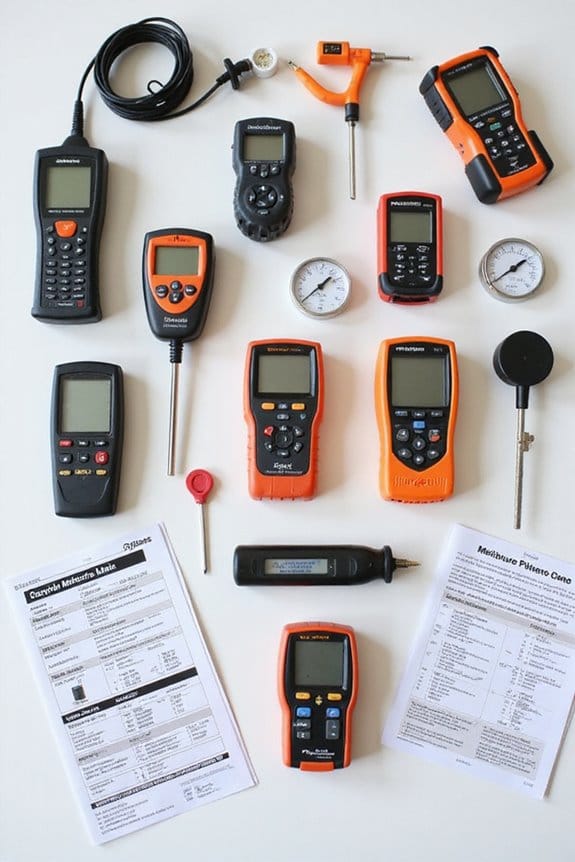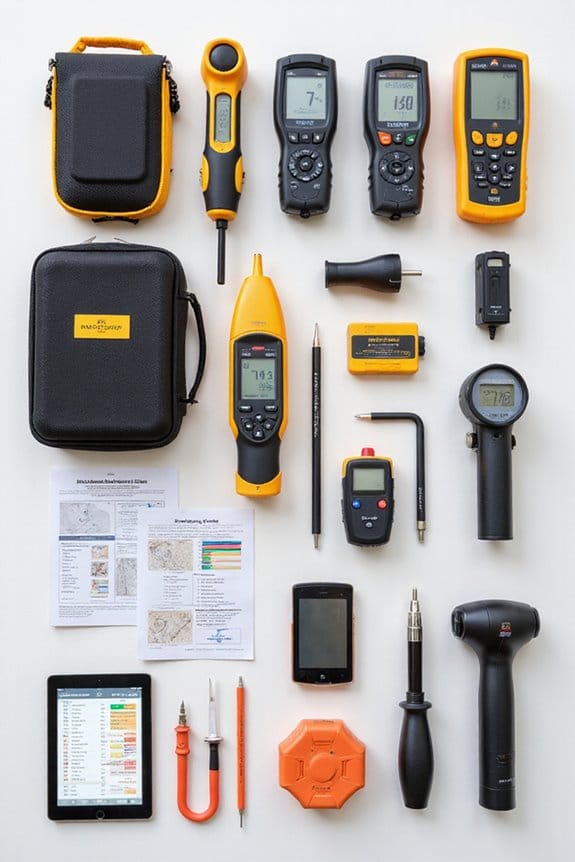When using a moisture meter, several key factors can affect its accuracy. Here are the main culprits:
- Material Type: Different woods and other materials respond uniquely.
- Temperature: Hot or cold conditions can throw off readings.
- Surface Moisture: Wiping away any moisture is vital.
- Meter Condition: Regular calibration and clean electrodes are essential for accurate results.
By keeping these in mind, you’ll get better readings. Stick around, and I’ll share more helpful tips!
Key Takeaways
- Different materials require specific calibration, as wood species and other materials have unique densities that affect moisture readings.
- Regular meter calibration and maintenance, including cleaning and checking for damage, are crucial for accurate measurements.
- Environmental and material temperatures can skew readings; high temperatures may inflate moisture content, necessitating temperature corrections.
- Surface moisture can lead to false high readings, so wiping surfaces before testing enhances accuracy.
- The type of moisture meter used (pin-type vs. pinless) affects measurement precision, especially with irregular or dense materials.
Material Type and Composition
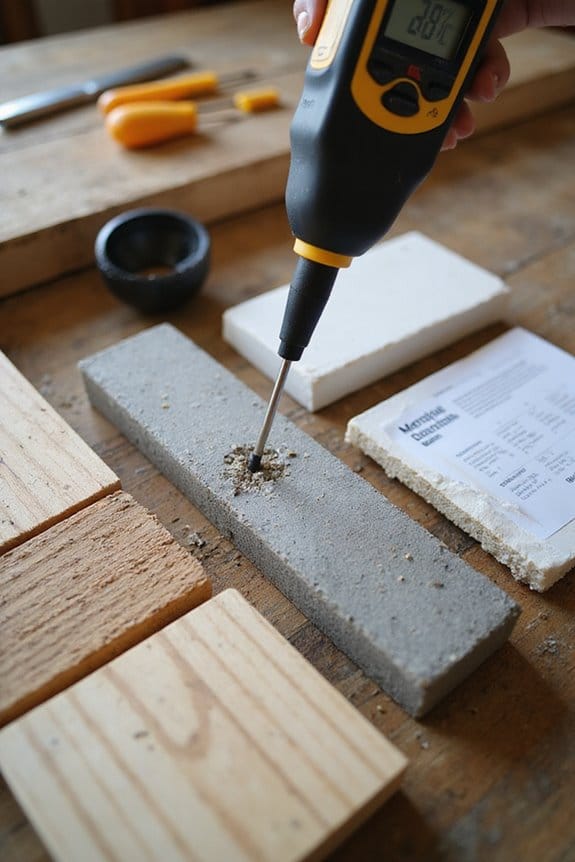
When it comes to using moisture meters, understanding the material type and composition is essential—after all, not every material behaves the same way. Here’s why:
- Material Species: Different wood species have unique densities and resin contents. This affects how moisture meters respond.
- Moisture Distribution: Materials like hay or grain need specialized pin-type meters, as pinless ones can give you misleading readings.
- Calibration: Always calibrate your meter for the specific material. Using the wrong scale? You might be overestimating or underestimating moisture content.
- Surface Effects: Coatings or contaminants can hinder accurate readings.
- Material versatility is crucial as it influences the choice between pin-type and pinless meters for accurate assessments.
Material and Environment Temperature
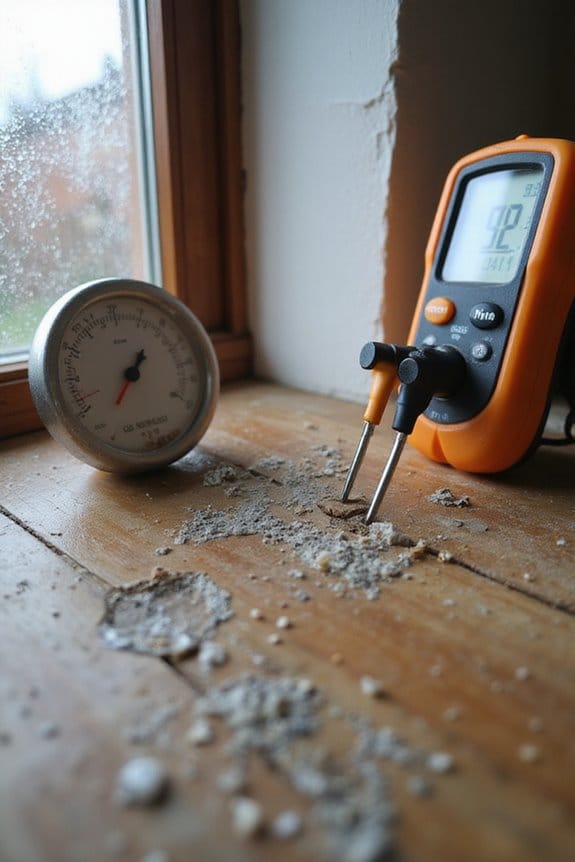
Understanding how material and environmental temperatures affect moisture meter accuracy is essential if you want reliable readings. Here’s what you need to know:
- Material Temperature: High temperatures can inflate moisture readings. Always apply temperature correction to avoid overestimating moisture levels.
- Environmental Stability: While typical indoor temperatures don’t cause major issues, extreme hot or cold can lead to inaccurate readings.
- Calibration: If you’re working in freezing conditions, make sure to calibrate correctly. Meters can overestimate moisture by 6-7% if you don’t!
- Quick Tip: Use temperature correction charts to adjust readings based on material type. Additionally, measurement accuracy is crucial to prevent mold growth and structural damage, highlighting the importance of considering temperature factors.
Surface Moisture and Condensation

Surface moisture and condensation can throw a real wrench into your moisture meter readings, and trust me, that’s not something you want to deal with. Here’s why you should pay attention:
- False High Readings: Surface moisture can make your meter register higher levels than what’s really there. This is especially true for pin meters.
- Condensation Effects: When the temperature of your material differs from the air, condensation forms. This thin film can lead to transient spikes in readings that aren’t accurate.
- Meter Sensitivity: Even quality meters can fall victim to these issues, but budget models are more prone to errors.
To get accurate results, wipe away any surface moisture and let things dry out before testing. It’ll save you a lot of headaches!
Meter Condition and Calibration
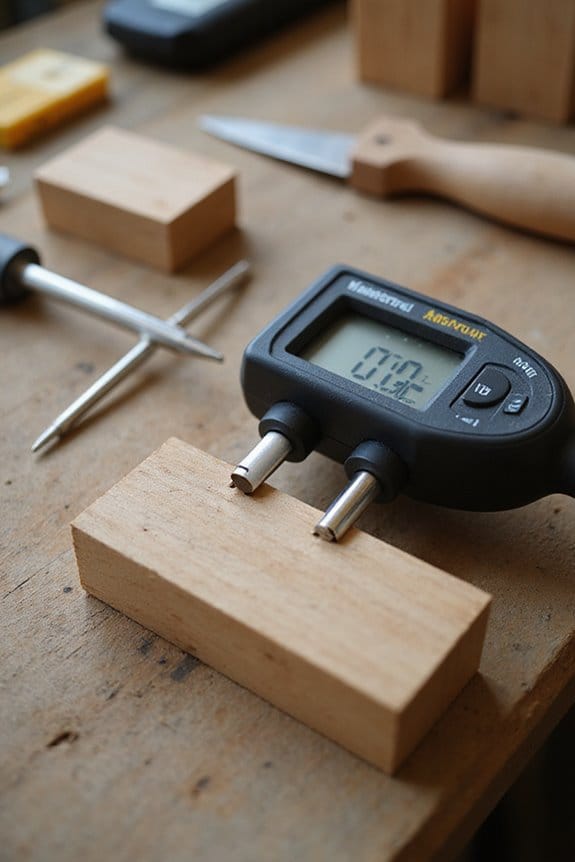
Although I might not be a meter expert, I can tell you that the condition of your moisture meter is vital for getting accurate readings. Here are a few key points to take into account:
- Calibration Frequency: Regular calibration is important, especially after battery changes or long periods of non-use. Think of it as a tune-up for your meter.
- Meter Maintenance: Keep your meter clean and check for any damage. Worn electrodes can lead to inaccurate readings, even if it was recently calibrated.
- Environmental Care: Store your meter properly to prevent moisture from affecting its electronics. Additionally, ensure that you are using the correct measurement types for your specific application to maintain accuracy.
Meter Type and Technology
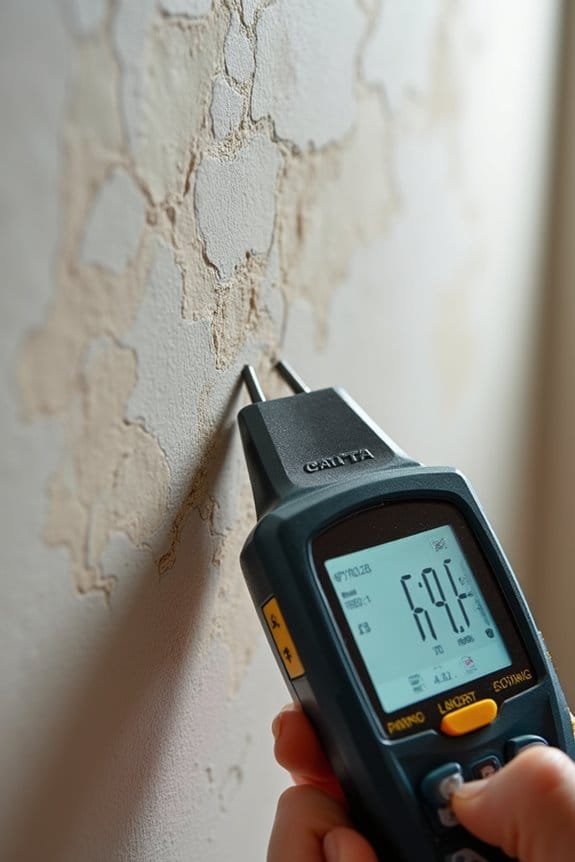
When it comes to measuring moisture, the type of meter you choose can make a world of difference in accuracy and usability. Here’s a quick breakdown of the most common meter technologies:
- Pin-Type Meters: These use metal pins to measure resistance. They’re precise but can damage surfaces.
- Pinless Meters: They scan without penetrating the material. Great for larger areas but can be influenced by surface conditions.
- NIR Sensors: Super accurate, measuring within 0.1% moisture content, but require calibration.
- TDR Meters: They send electromagnetic pulses, providing rapid measurements at various depths.
- IR Meters: Non-contact and instant, but surface texture can skew results.
Choosing the right device affects both meter precision and your overall success in moisture measurement. Color-coded LEDs enhance usability by quickly indicating moisture levels. Happy measuring!
Measurement Technique and Repetition
Getting accurate moisture readings isn’t just about having the right meter; it also hinges on how you measure. Here’s what I’ve learned about ensuring measurement consistency and reading reliability:
- Multiple Readings: Always take several measurements from the same area. This helps smooth out any anomalies and confirms accuracy.
- Consistent Technique: Use the same pressure and depth for pin-type meters. Even slight changes can skew results.
- Surface Preparation: Clean the testing area. Dust and moisture can interfere with your readings, so a little prep goes a long way.
- Averaging Results: Don’t rely on a single measurement. Averaging multiple readings not only boosts confidence but also compensates for any material quirks. Additionally, understanding the non-destructive testing capabilities of your moisture meter can enhance measurement accuracy by preventing surface damage.
Environmental Influences
Environmental factors can play a significant role in the accuracy of moisture meter readings, and understanding these influences is essential for reliable results. Here are a few key points to keep in mind:
- Ambient Humidity: High humidity can cause moisture to build up on surfaces, leading to misleading readings. So, if it’s raining cats and dogs outside, be cautious!
- Weather Fluctuations: Changes in weather can impact moisture levels. For instance, direct sunlight can dry out surfaces, causing underreporting of moisture content.
- Consistent Conditions: Testing in stable environments helps improve accuracy. If you can, try to measure moisture when the weather’s calm.
User Handling and Technique
Though many factors can affect moisture meter readings, how you handle and use the device is just as vital for accuracy. Here are some key points to reflect on for measurement consistency:
- Operator Training: Knowing your meter’s functions and limitations is essential. Inaccurate readings can stem from misunderstandings, so training is key!
- Contact Technique: For pin meters, insert pins firmly and consistently. For pinless meters, guarantee full contact with the material.
- Stabilize Readings: Take a moment to let your meter stabilize before reading. Quick checks can lead to errors.
- Multiple Readings: Don’t just take one reading! Gather several from different spots to get a clearer picture.
Electrical Interference
When it comes to moisture meters, electrical interference can be a sneaky culprit that throws off your readings. Here’s what to watch out for:
- Electrical Shorts: Moisture intrusion can cause shorts, leading to inaccurate measurements.
- Calibration Drift: Over time, components degrade, so regular calibration verification is essential to guarantee accuracy.
- Cables: Don’t underestimate the power of those cables! Handling them can introduce up to a 2% variation in your readings.
- Surface Moisture: Water on the surface can skew results, especially with pin meters.
Material Density and Structure
Understanding material density and structure is essential for accurate moisture meter readings. Here’s why:
- Density Variations: Denser materials show higher electrical resistance. This can lead to inaccurate readings if not accounted for.
- Structural Anomalies: Irregularities, like knots in wood, complicate moisture detection. Pinless meters struggle here because they average readings over a scanned area.
- Calibration: It’s vital to calibrate your meter for specific material densities. Failing to do so can result in misleading data.
- Depth of Measurement: Pin insertion depth matters. Shallow readings often miss deeper moisture pockets, especially in dense materials.
Frequently Asked Questions
How Does Moisture Meter Brand Influence Accuracy?
When choosing a moisture meter, I’ve noticed brand reputation and technology advancements play vital roles in accuracy. Established brands often provide better quality control, ensuring I get reliable readings for my projects.
Can Age of Materials Affect Moisture Readings?
They say time waits for no one, and materials are no exception. I’ve noticed that material degradation can affect moisture retention, leading to inaccurate readings over time. Always consider a material’s age when measuring moisture.
What Role Does Humidity Play in Moisture Measurements?
Humidity levels considerably impact moisture measurements. I’ve noticed that high humidity can lead to inaccurate readings due to moisture absorption by materials. It’s crucial to take into account these factors for reliable moisture meter results.
How Do User Errors Impact Moisture Meter Results?
User handling’s essential; I’ve found improper measurement techniques can skew results considerably. If I don’t apply the right pressure or follow instructions, my readings can easily misrepresent the actual moisture content, leading to errors.
Are There Specific Calibration Standards for Different Industries?
Absolutely, I’ve found that calibration techniques vary considerably across industries. Each sector adheres to specific industry standards to guarantee accurate moisture readings, reflecting the unique materials and requirements they deal with daily.

